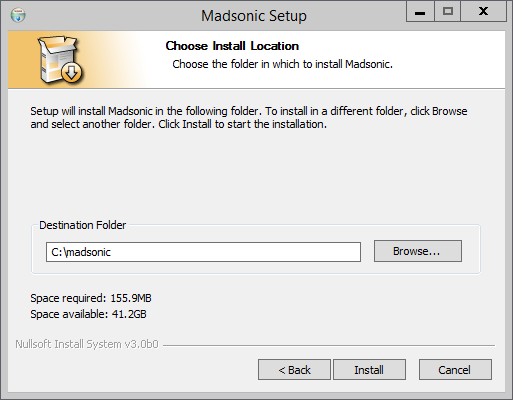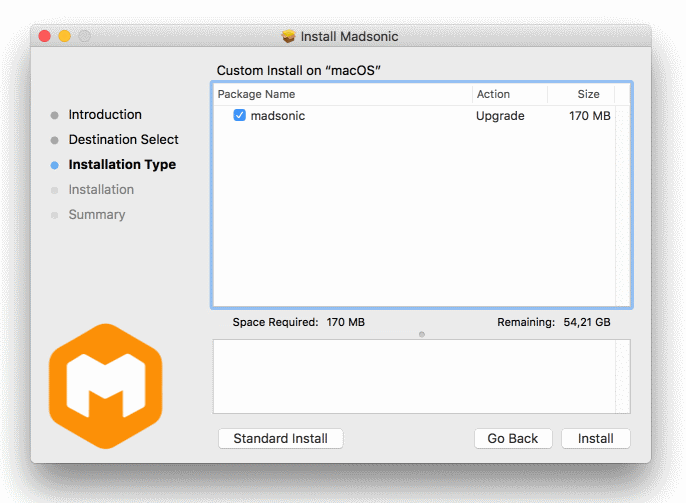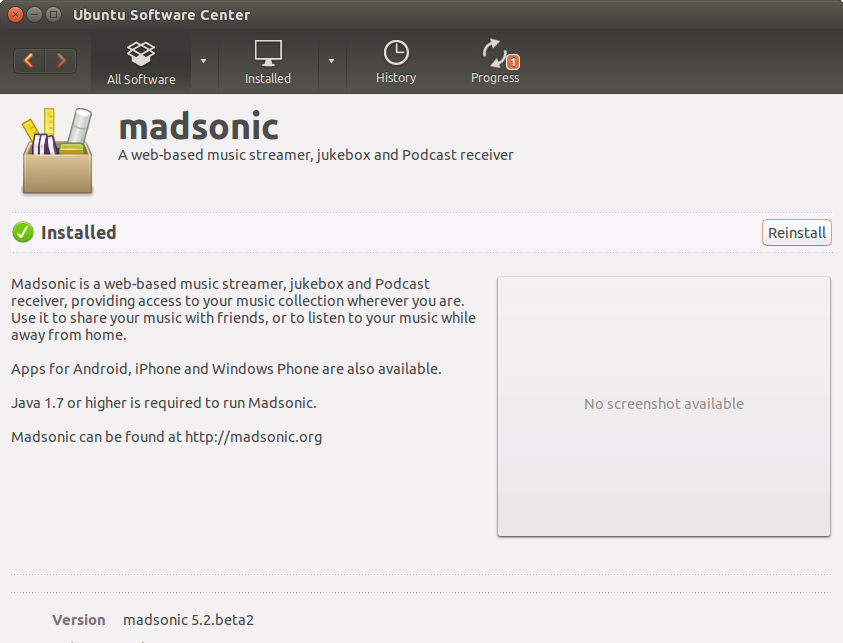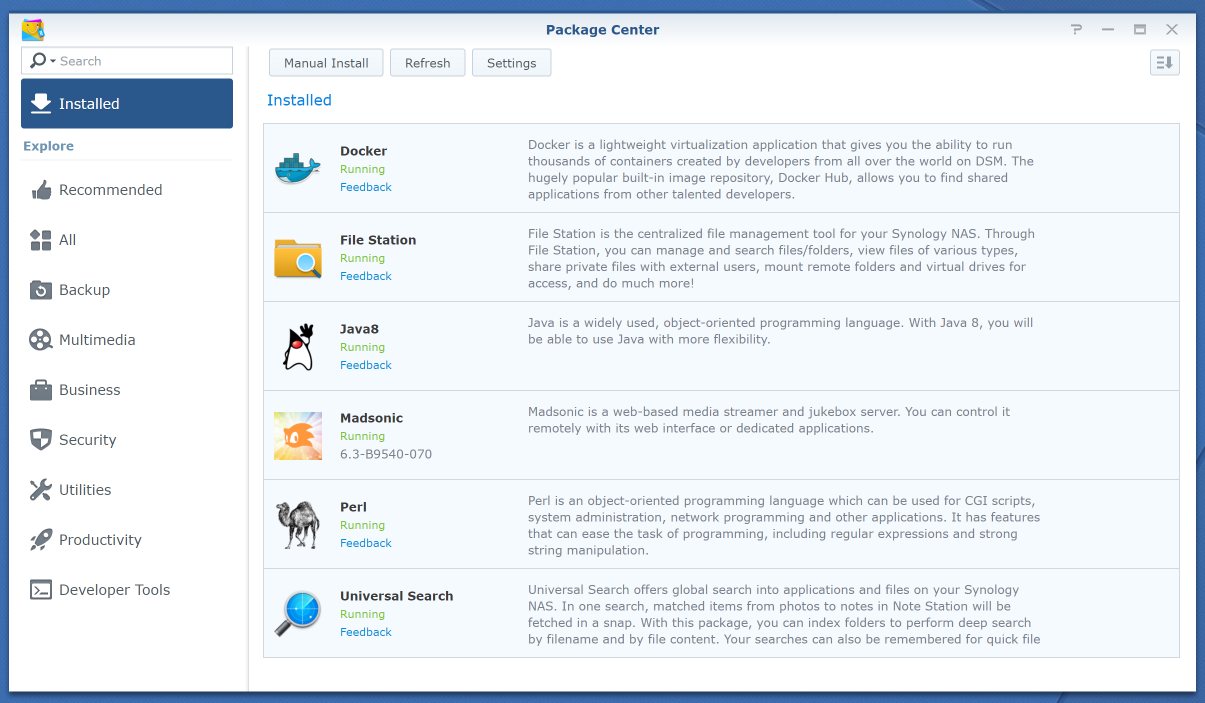Madsonic features several flexible installation options. Select the one which suits you best:
Immediately after installing Madsonic you should change the admin password to secure the server.
Point your browser to the Madsonic web page (see URL below), and log in with username admin and password
admin. Go to Settings > Users to change password and create new users.
Java is a technology originally developed by Sun Microsystems, and acquired by Oracle. The following are the prevalent implementations:
To add the WebUpd8 Oracle Java PPA repository and install Oracle Java in Ubuntu, use the following commands:
sudo add-apt-repository ppa:webupd8team/java
sudo apt-get update
sudo apt-get install oracle-java8-installersudo apt-get install oracle-java8-set-default
To add the WebUpd8 Oracle Java PPA repository and install Oracle Java in Debian, use the following commands:
sudo echo "deb http://ppa.launchpad.net/webupd8team/java/ubuntu trusty main" | tee -a /etc/apt/sources.list
sudo apt-key adv --keyserver hkp://keyserver.ubuntu.com:80 --recv-keys EEA14886
sudo apt-get update
sudo apt-get install oracle-java8-installer
After the installation is finished and you wish to see if it was successfully, you can run the following shell command:
java -version
It should return something like this:
Java version "1.8.0_131"
Java(TM) SE Runtime Environment (build 1.8.0_131-b11)
Java HotSpot(TM) 64-Bit Server VM (build 25.131-b11, mixed mode)
If for some reason, the Java version in use is not 1.8.x, you can try to run the following command:
to display: sudo update-java-alternatives --list
to config: sudo update-alternatives --config java
To add Java, use the following installer: Java 8 or later (Download).
After the installation is finished and you wish to see if it was successfully, you can run the following shell command:java -versionJava version "1.8.0_131"Java(TM) SE Runtime Environment (build 1.8.0_131-b11)Java HotSpot(TM) 64-Bit Server VM (build 25.131-b11, mixed mode)To add Java, use the following installer: Java 8 or later (Download).
After the installation is finished and you wish to see if it was successfully, you can run the following shell command:java -versionJava version "1.8.0_131"Java(TM) SE Runtime Environment (build 1.8.0_131-b11)Java HotSpot(TM) 64-Bit Server VM (build 25.131-b11, mixed mode)
On Windows, the easiest way to install Madsonic is using the provided Windows Installer: madsonic-x.x-setup-xx.exe.
It installs Madsonic as a service, available in Control Panel > Administrative Tools > Services, that is started automatically when you log on to Windows.
It also creates links in the Start Menu: Start > All Programs > Madsonic. From this menu you can start/stop the Madsonic service, open the Madsonic web page, or
change basic settings such as which port number Madsonic should use. You can also click on the little yellow submarine tray icon.
If you're upgrading an existing Madsonic installation, you don't have to uninstall the old version first. In any case, the existing Madsonic settings are preserved.
After installing and starting Madsonic, open the Madsonic web page on http://localhost:4040.

Requirements: Java 8 or later (Download).
Download the installation package and run it. This installs Madsonic.app in Applications. Start it by opening Applications and click the Madsonic icon. A small Madsonic icon will appear in the menu bar. If you want Madsonic to start automatically when you log in, open System Preferences > Accounts and add Madsonic to the list of Login Items.
After installing and starting Madsonic, open the Madsonic web page on http://localhost:4040.
Advanced configuration
To change the port number, Java memory settings or other startup parameters, edit /Applications/Madsonic.app/Contents/MacOS/universalJavaApplicationStub.
Troubleshooting
If Madsonic doesn't start properly you can troubleshoot it by starting it from the command line:
/Applications/Madsonic.app/Contents/MacOS/universalJavaApplicationStub.
Also check the logs in /Library/Application Support/Madsonic.

This installation option applies to Debian Linux, including Ubuntu.
sudo apt-get install openjdk-8-jresudo dpkg -i Madsonic-x.x.xxxx.debNotice that the installer configures your system to start Madsonic automatically when booting. After installing, open the Madsonic web page on http://localhost:4040.
Change user
By default the Madsonic process is run as the root user. To improve security it is strongly advised that you run it as a
dedicated user with less powerful privileges. You can specify this user by setting the MADSONIC_USER variable in
/etc/default/madsonic.
Note that non-root users are by default not allowed to use ports below 1024. Also make sure to grant the user write permissions in the music directories, otherwise changing album art and tags will fail.
Advanced configuration
To change the port number, Java memory settings or other startup parameters, edit the MADSONIC_ARGS variable in
/etc/default/madsonic. To restart Madsonic, do
sudo service madsonic restart
Troubleshooting
Check the logs in /var/madsonic.
This installation option applies to Red Hat Linux, including Fedora.
sudo yum install java-1.8.0-openjdksudo yum install --nogpgcheck Madsonic-x.x.xxxx.rpmsudo yum remove MadsonicNotice that the installer configures your system to start Madsonic automatically when booting. After installing, open the Madsonic web page on http://localhost:4040.
Change user
By default the Madsonic process is run as the root user. To improve security it is strongly advised that you run it as a
dedicated user with less powerful privileges. You can specify this user by setting the MADSONIC_USER variable in
/etc/sysconfig/madsonic.
Note that non-root users are by default not allowed to use ports below 1024. Also make sure to grant the user write permissions in the music directories, otherwise changing album art and tags will fail.
Advanced configuration
To change the port number, Java memory settings or other startup parameters, edit the MADSONIC_ARGS variable in
/etc/sysconfig/madsonic. To restart Madsonic, do
sudo service madsonic restart
Troubleshooting
Check the logs in /var/madsonic.
This installation option applies to Centos.
sudo yum install java-1.8.0-openjdksudo yum install --nogpgcheck Madsonic-x.x.xxxx.rpmsudo yum remove MadsonicNotice that the installer configures your system to start Madsonic automatically when booting. After installing, open the Madsonic web page on http://localhost:4040.
Change user
By default the Madsonic process is run as the root user. To improve security it is strongly advised that you run it as a
dedicated user with less powerful privileges. You can specify this user by setting the MADSONIC_USER variable in
/etc/sysconfig/madsonic.
Note that non-root users are by default not allowed to use ports below 1024. Also make sure to grant the user write permissions in the music directories, otherwise changing album art and tags will fail.
Advanced configuration
To change the port number, Java memory settings or other startup parameters, edit the MADSONIC_ARGS variable in
/etc/sysconfig/madsonic. To restart Madsonic, do
sudo service madsonic restart
Troubleshooting
Check the logs in /var/madsonic.
Requirements: Java 8 or later (Download)
This is Madsonic with an embedded Jetty server, and can be installed on any Windows, Linux, Unix, FreeNAS, unRAID etc operating system.
madsonic-x.x.xxxx-standalone.tar.gz to MADSONIC_HOME/standalone.
MADSONIC_HOME is typically c:\madsonic /var/madsonic on Unix-based operating systems.MADSONIC_HOME/standalone/madsonic.shRequirements: Java 8 or later (Download).

Public<Public>\Madsonic (for backup/restore)madsonic-6.x.xxxx-DSM6.spkJava Notes
https://bugs.openjdk.java.net/browse/JDK-8175885 Link http://bugs.java.com/view_bug.do?bug_id=8173960 Link Install Notes
Advanced configuration
To change the port number, Java memory settings or other startup parameters, edit
the variables in
/usr/syno/synoman/webman/3rdparty/Madsonic/madsonic.sh.
Troubleshooting
Check the logs in /usr/syno/synoman/webman/3rdparty/Madsonic/madsonic_sh.log.
Requirements: Java 8 or later (Download). A servlet container supporting Servlet 2.4 and JSP 2.0.
Use this option if you want to deploy Madsonic in an external server, such as Tomcat, Jetty, GlassFish or Geronimo. Madsonic comes
packaged as a standard Java web application, madsonic.war, which can be easily deployed in any compatible servlet container.
The most commonly used server is Tomcat, and the rest of this section describes how to install or upgrade Madsonic on a Tomcat server.
TOMCAT_HOME/webapps/madsonic.warTOMCAT_HOME/webapps/MadsonicTOMCAT_HOME/workmadsonic.war to TOMCAT_HOME/webapps.Notes
Control Panel > Administrative Tools > Services.TOMCAT_HOME refers to the directory in which you installed Tomcat.C:\Program Files\Apache Software Foundation\Tomcat 8.0/var/madsonic. Depending on your configuration, Tomcat may not be permitted to create this directory, in which case
you have to create it manually: mkdir /var/madsonic; chown tomcat:tomcat /var/madsonicTroubleshooting
If you experience any problems, please make sure you follow the installation instructions above. Here's a list of suggestions of what to do if it still doesn't work:
c:\madsonic\madsonic.log or /var/madsonic/madsonic.log.TOMCAT_HOME/logs.
madsonic/
│
├── madsonic.sh
├── madsonic.bat
├── madsonic.log
├── madsonic.war
├── madsonic-booter.jar
├── madsonic.properties
│
├── lastfmcache/
│ └── last.fm cache ...
│
├── genre/
│ └── genremap.cfg
│
├── conversion/
│ ├── audio/
│ └── video/
│
├── db/
│ ├── madsonic.data
│ ├── madsonic.script
│ └── madsonic.properties
│
├── db.backup/
│ └── backup files ...
│
├── jetty/
│ └── app cache ...
│
├── picons/
│ └── channel picture cache ...
│
├── lucene66/
│ └── search cache ...
│
├── logs/
│ └── log files ...
│
└── thumbs/
│ └── thumbnail cache ...
│
└── transcode/
├── ffmpeg.exe
├── lame.exe
└── xmp.exe
/madsonic.properties
#Madsonic preferences.
LogfileLevel=DEBUG
Port=8080
HttpsPort=0
ScanMode=MIXED
GettingStartedEnabled=false
UploadFolder=f\:\\Media\\Incoming
PodcastFolder=f\:\\Media\\Podcast
PlaylistBackupFolder=f\:\\Media\\Playlists\\Backup
PlaylistExportFolder=f\:\\Media\\Playlists\\Export
PlaylistImportFolder=f\:\\Media\\Playlists\\Import
TranscodeFolder=d\:\\madsonic\\transcode
Theme=madsonic_4kblack